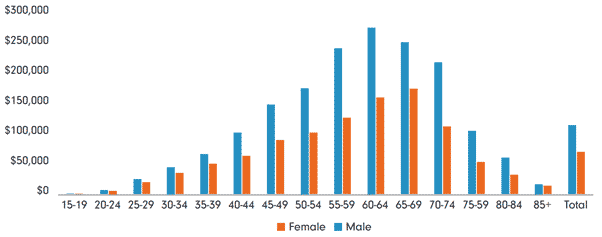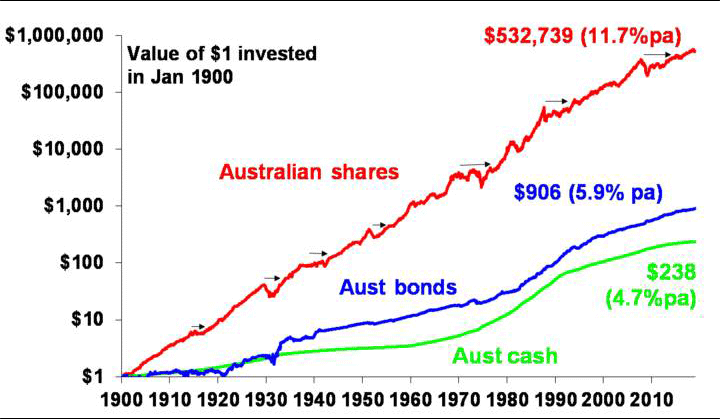5 steps women can take to improve their retirement readiness
Contributing authors: Shani Jayamanne, investment Specialist, Morningstar Australia, Emma Rapaport, editorial manager, Morningstar Australia and Christine Benz, director of personal finance, Morningstar Inc.
Women’s superannuation is not so super. At retirement, Australian women on average have $157,050 whereas men have $270,710—a gap of $113,660, according to data released by the Association of Superannuation Funds of Australia in 2018. The gap between women and men extends to younger cohorts too. Women aged 30-34 have balances of $33,750, whereas men have $43,580. The gap is closing, albeit slowly.
Why women are lagging behind
The reasons are manifold, but a few factors loom large. Women have lower lifetime earnings than men, due to wage inequality, a reluctance to negotiate for better pay and the reality that women are more likely to stop working or maintain a reduced schedule to devote time to caregiving for children, elderly parents, or both. Women in Australia earn an average of 14.6 per cent less than men, and in full-time roles that number rises to 22.4 per cent, according to the Financy Women’s Index.
In addition, women must stretch those smaller average balances over a longer time frame in retirement as 65-year-old women outlive their male counterparts by two years, on average.
For women, childbearing and caring responsibilities form the largest portion of career breaks despite the advances in maternity leave benefits. The legally mandated 18 weeks of paid parental leave still falls short of 32 weeks that the average mother takes. Under existing legislation, employers are not required to make superannuation contributions for employees on paid parental leave. This leaves a potential 32 weeks without any kind of superannuation contribution. For 14 of those weeks there is also no income earned. And it goes without saying that having children is one of life’s most expensive events. The result of one or more career breaks is often a lower superannuation balance at retirement.

Source: Association of Superannuation Funds of Australia
There’s no easy fix for the problem, but women should consider the following steps to help stave off a shortfall.
What to do about it
Take control of your retirement savings
Many Australians have no idea if they have a super. And if they do, they most likely don’t know which fund they’re with. More than 40 per cent of Australians have several superannuation accounts which are collectively costing us more than $1.96 billion in fees each year, according to consumer advocate Choice—fees which may well be unnecessary.
Consider transferring all your savings into one fund. This will help stop multiple fund fees from eating into retirement savings. And while you’re there, take some time to understand exactly how much you’re paying in fees, where your funds are invested, what insurance you hold, and your fund’s long-term performance.
Maximise contributions before, during, and after work disruptions
Much of the gender gap in lifetime earnings, and in turn retirement savings, is because women are much more likely than men to cut back on paid work or quit altogether to care for children or other family members. Those life decisions are about more than money, and women don’t always have complete control over their employers or the duration of caregiving responsibilities. But to the extent that it is possible, women who anticipate that their work trajectories could be affected by caregiving should prioritise employers with family-friendly policies such as paid parental leave and flexible work hours.
The data also show that women’s earnings tend to peak earlier than men’s, no doubt in part because of caregiving responsibilities for many. That accentuates the merits for women taking advantage of the concessional (before-tax) tax treatment on additional super contributions. In addition to compulsory payments by your employer, these contributions could include salary-sacrifice payments or further amounts paid to super by your employer before tax.
There are a couple of methods that can help you bridge the gap created by a career break.
1. Salary sacrifice while you are earning an income:
You can salary sacrifice $25,000 a year (total including employer contributions) into your superannuation as pre-tax contributions, taking advantage of the tax benefits this brings. The amount you can contribute will vary based on personal circumstances, but ASIC’s MoneySmart has a ‘Superannuation Optimiser’ tool on their website, as well as other calculators that can assist with understanding how contributions can affect outcomes.
2. Plan for super contributions as part of your career break:
This method ensures there are minimal changes to your superannuation balance but requires time and investment beforehand. When you are saving for a planned career break, ensure that superannuation contributions are included in the calculation process. Contribute as your employer would during the period. Remember, these contributions will be treated as non-concessional. If your pre-tax contributions are below $25,000 for that financial year, your superannuation fund can provide you with an ‘S290 form’—a notice of intent to claim or vary a deduction for personal super contributions. This will give you a tax deduction on your contributions made.
Get off the sidelines
Research on women’s investing behaviours is all over the map: Studies have pointed to women investing more conservatively than men, trading less, being more patient, or being more goals-oriented. Other research indicates that once you control for income, women’s investing behaviour is very similar to men’s.
A few findings are consistent, though. One is that women tend to be more reticent to get their money invested. According to a study by Wealthsimple, women invest 40 per cent less money than men. When asked in a survey by Lexington Law what they would do with an extra $1000, men were 35 per cent more likely to say they would invest the money. As Sallie Krawcheck, CEO and co-founder of the Ellevest investing service for women, put it, “Our rival is really cash. You know, that’s our biggest competition. It’s cash and inertia.” That tendency, combined with the fact that women live longer than men, on average, contributes to the likelihood that women will have a shortfall in retirement.”
What you can achieve by investing
Shares versus bonds and cash over very long term—Australia

Source: Global Financial Data, AMP Capital
The above chart shows the returns of different asset classes over a long-term period; in this case, an investment of $1 in 1900 (with income reinvested). The green line shows Australian cash returns $238; Australian shares, the red line, shows a return of $532,739. No one has a 110-year investing journey, but the principle remains—investing has helped people grow wealth; and staying invested in an asset over the long-term is decidedly more lucrative. That said, the purpose of this chart is not to convince you to pull all of your cash out of the bank and put it into Australian shares. Rather, it illustrates that cash has almost always been seen as a ‘safe’ option—if you keep it there you’ll earn some interest and there’s little to no risk of losing your savings. There is always a trade-off when it comes to risk, and in this case it is the risk of not achieving your goals. Cash might feel like a comfortable option, but it may mean the risk of a less comfortable retirement or the risk of compromising on other lifestyle goals in the lead-up to retirement.
Note: Your money may be safe in the bank but its purchasing power also risks being eroded by inflation. Inflation is the sustained rise in the price of goods and services over time. In other words, that dollar you possess today is worth less than a dollar tomorrow. As the value of money decreases, the price of goods and services in the economy increase.
Consider working longer
Many factors affect how long we’ll work-lifestyle and health considerations, as well as being able to stay employed and caregiving obligations. The fact that our retirement dates may be out of our control is why Morningstar contributor Mark Miller has referred to working longer as “a worthy aspiration, not a retirement plan.” And research from Morningstar Investment Management head of retirement research David Blanchett indicates that retirees who expect to work longer are often unable to do so. Our retirement dates are less in our control than we might like to believe.
That said, the financial (and possibly other) benefits of working longer are undeniable: Additional retirement-plan contributions, delayed portfolio withdrawals, a shorter drawdown period can all help bolster the viability of a retirement plan. The benefits of delaying retirement are especially great for women, in that interrupted work trajectories (for caregiving, see above) and longer life expectancies compound the stresses placed on retirement assets. For women hurtling toward retirement shortfalls, delaying retirement will be the single-most financially impactful decision they can make. That’s just one reason for maintaining work skills through investments in continuing education, combating ageism, and investing in physical health.
It’s also worth noting that “working longer” doesn’t necessarily mean sticking it out in a job that makes you miserable. If you can tick a couple of the working longer benefits outlined above = for example, delaying portfolio withdrawals even if you aren’t earning enough to make additional retirement plan contributions—that can still improve your plan.
Lay a plan for healthcare costs
According to the Australian Institute of Health and Welfare, women experience distinctly different health outcomes to men. Their life expectancy is longer, but their ‘total disease burden’ is also higher as women are more likely to live with a chronic disease than die early from a disease. Women are also more likely to experience chronic conditions that require ongoing support.
As you reach retirement, you are far more likely to develop chronic conditions (half of Australian women have one or more) that requires specialist care. Australia has one of the best universal health programs in the world, but despite this it is not comprehensive when it comes to ongoing specialist care.
As you go further into retirement, dementia and Alzheimer’s disease become the leading cause of death for women. These conditions can require care for ongoing periods—all of which are a consuming financial burden.
Although these situations are mostly unavoidable financially, the impact can be minimised by investing early to ensure you are able to meet the healthcare costs associated with age. Exact amounts or dollar amount goals are hard to define for future healthcare costs, but this is another key reason why planning is crucial—not only because of the disparity in women’s wages, life expectancy, career breaks, superannuation balances and health outcomes, but because the culmination of these factors will often multiply in the form of lost investment earnings, and a lower quality of life in retirement.





